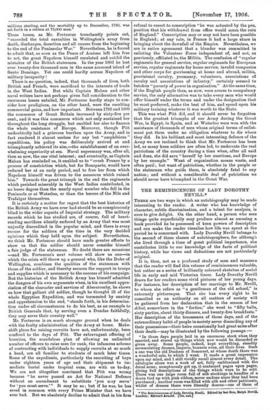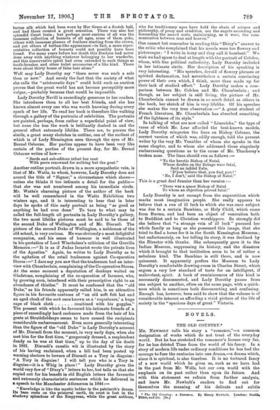THE REMINISCENCES OF LADY DOROTHY NEVILL.*
THERE are two ways in which an autobiography may be made interesting to the reader. A writer who has knowledge of
character, subtle discrimination, and a talent for analysis, is sure to give delight. On the other hand, a person who sees things quite superficially may produce almost as amusing a book provided he be possessed of keen powers of description and can make the reader visualise how life was spent at the period he is concerned with. Lady Dorothy Nevill belongs to the second of these classes of autobiographers, for although she lived through a time of great political importance, she contributes little to our knowledge of the facts of political history, while her views and deductions are not particularly original.
It is, then, not as a profound study of men and manners that the reader will find this volume of reminiscences valuable, but rather as a series of brilliantly coloured sketches of social life in early and mid Victorian times. Lady Dorothy Nevill draws for her readers some vivid pictures of her young days.
For instance, her description of her marriage to Mr. Nevill, to whom she refers as "a gentleman of the old school," is
extremely picturesque. That she has every right to be consulted as an authority on all matters of society will be gathered from her declaration that in the season of her debut, somewhere in the "forties," she went to "fifty balls, sixty parties, about thirty dinners, and twenty-five breakfasts." Her description of the trousseaux of those days, and of the extraordinary habit of people in society never discarding any of their possessions—their heirs occasionally had great sales after their death—may be illustrated by the following passage :— "In those days ,people laid in an enormous stock when they married, and stored up things which now would be discarded or given away. Some people, indeed, kept everything, steadily accumulating dresses, lingerie, bonnets even, all their lives. Such a one was the old Duchess of Somerset, at whose death there was a wonderful sale, to which I went. It made a great impression upon my mind, and I still vividly recall almost every detail. The catalogue alone was a work of art, fully emblazoned with the ducal arms; sumptuously got up, it contained pages upon pages, giving full descriptions of the things which were to be sold. There was one large room full of silk stockings in bundles of a dozen tied up with pink ribbon, never undone since they had been purchased ; another room was filled with silk and other petticoats, whilst of dresses there were literally dozens—one of them of • The Reminiscences of Lady Dorothy Naval. Edited by her Beni Ralph Nevin. London; Edward Arnold. [15s. net.] tartan silk which had been worn by Her Grace at a Scotch ball, and had there created a great sensation. There was also her splendid Court train ; but perhaps most curious of all was the immense collection of bonnets of all ages, some of them poke, others with immense plumes of feathers starting from the crown, and yet others of turban-like appearance—in fact, a more repre- sentative collection of bonnets could not possibly have been found. For many years before her death this Duchess had never done away with anything whatever belonging to her wardrobe, and this conservative spirit had even extended to such things as tooth-brushes and other toilet accessories of a like kind. There were about thirty boxes of false hair alone."
Well may Lady Dorothy say " there never was such a sale then or now." And surely the fact that the society of what she calls the " aristocratic days " could hold such an auction proves that the great world has not become perceptibly more vulgar,—probably because that would be impossible.
Lady Dorothy Nevill is exceedingly generous to her readers. She introduces them to all her best friends, and she has known almost every one who was worth knowing during every epoch of her life. To read her book is therefore like walking through a gallery of the portraits of celebrities. The portraits are painted, perhaps, from rather a superficial point of view, but none the less the work is brilliantly dashed in and the general effect extremely lifelike. There are, to pursue the simile, a great many sketches in outline, one of the earliest of which is of Lady Blessington seen through the eyes of Mr. Bernal Osborne. Her parties appear to have been very like certain of the parties of the present day, for Mr. Bernal Osborne writes of how-
" Bards and sub-editors infest her rout
With peers renowned for nothing but the gout."
Another outline portrait, drawn in a more sympathetic vein, is
that of Mr. Watts, to whoni, however, Lady Dorothy does not accord the title of "Signor," a circumstance which shows—
unless she thinks it too intimate a detail for the public— that she was not numbered among his immediate circle. Mr. Watts's charming picture of the author of the book will be well remembered in the Watts Exhibition two winters ago, and it is interesting to hear that in later days he spoke of this early portrait as being " as good as anything he had ever done." To turn to what may be called the full-length oil portraits in Lady Dorothy's gallery, the two most lifelike pictures must be said to be those of the second Duke of Wellington and of Mr. Disraeli. The picture of the second Duke of Wellington, a nobleman of the old school, is very curious. He was obviously a most delightful companion, and his sense of humour is well illustrated in his quotation of Lord Winchelsea's criticism of the Greville Memoirs :—" It is as if Judas Iscariot wrote the private lives of the Apostles." Again, he writes to Lady Dorothy as to the agitation of the retail tradesmen against Co-operative Stores :—" I dare say you saw that the tradesmen had an inter- view with Chamberlain, complaining of the Co-operative Stores.
At the same moment a deputation of donkeys waited on Gladstone, complaining of the co-operation of farmers, who, by growing corn, interfered with their prescriptive right to an abundance of thistles." It must be confessed that the "old Duke," as his friends apparently called him, is an attractive figure in his favourite costume of "an old soft felt hat and an aged cloak of the sort once known as a roquelaure,' a huge cape of black cloth combined with his goggles."
The present with which he favoured his intimate friends of a piece of exceedingly hard cashmere made from the hair of his goats at Strathfieldsaye seems to have caused the recipients considerable embarrassment. Even more generally interesting than the figure of the "old Duke" is Lady Dorothy's account of Mr. Disraeli from the moment, in very early days, when she met him for the first time, " gorgeously dressed, a resplendent
dandy as he was at that time," up to the day of his death in 1881. Disraeli's caustic wit is illustrated by the story
of his having exclaimed, when a bill had been posted up warning electors to beware of Disraeli as a Tory in disguise : "A Tory in disguise ! I will tell you who is a Tory in disguise--it is a Whig in place I" Lady Dorothy gives the world very few of "Dizzy's " letters to her, but tells us that she copied out for his benefit in old English letters the favourite and extremely characteristic sentences which he delivered in a speech to the Manchester Athenaeum in 1844 :—
" Knowledge is like the mystic ladder in the patriarch's dream. Its base rests on the primeval earth, its crest is lost in the shadowy splendour of the Empyrean, while the great authors,
who for traditionary ages have held the chain of science and philosophy, of poesy and erudition, are the angels ascending and descending the sacred scale, maintaining, as it were, the com- munication between man and heaven."
One cannot but remember in reading this " Dizzy's " answer to the critic who complained that his novels were too flowery and picturesque : "I write in irony and they call it bombast." We wish we had space to deal at length with the portrait of Cobden, whom, with fine political catholicity, Lady Dorothy included in her intimate circle. Her description of his speaking is very interesting. "His speeches, devoid of flowery phrases or spirited declamation, had nevertheless a certain convincing power of their own which, I think, more than made up for their lack of studied effect." Lady Dorothy makes a com- parison between Mr. Cobden and Mr. Chamberlain ; and though, as her subject is still living, the picture of Mr. Chamberlain cannot be drawn in so much detail as others in the book, her sketch of him is very lifelike. Of his speeches she makes the very true observation :—" A great student of French literature, Mr. Chamberlain has absorbed something of the lightness of its style."
In talking of what are now called " Limericks," the type of verse of which Mr. Lear afforded the best-known models, Lady Dorothy misquotes the lines on Bishop Coleus°, the correct version of which was, oddly enough, told the present writer by the very Mr. Venables of whom she speaks in the same chapter, and to whom she addressed those singularly embarrassing questions as to the cause of Mr. Thackeray's broken nose. The lines should run as follows :—
" To the heretic Bishop of Natal,
Whose doubts on the Deluge were fatal, Said an infidel Zulu, D'you believe that, you fool, you ? '
' No, I don't,' said the Bishop of Natal."
This is a great deal funnier than her version :— " There was a queer Bishop of Natal To whom an objection proved fatal."
Lady Dorothy is not exempt from the superstition which marks most imaginative people. She really appears to believe that a run of ill luck to which she was once subject was due to a certain Bambino, or Holy Child, which came from Burma, and had been an object of veneration both to Buddhist and to Christian worshippers. So strongly did she believe that "a strange vein of ill luck" pursued her whole family as long as she possessed this image, that she tried to find a home for it in the South Kensington Museum ; but unfortunately, on her telling its story, it was declined by the Director with thanks. She subsequently gave it to the Indian Museum, suppressing its history, and the disasters which it brought to that institution seem to be of rather a nebulous kind. The Bambino is still there, and is now quiescent. It apparently prefers the Museum to Lady Dorothy's comfortable drawing-room in Charles Street, which argues a very low standard of taste for an intelligent, if malevolent, spirit. A book of reminiscences of this kind is necessarily disconnected, and Lady Dorothy passes from one subject to another, often on the same page, with a quick- ness which is sometimes both disconcerting and confusing.
Enough has, however, been said to show that the volume is of considerable interest as affording a vivid picture of the life of society in the "spacious days of great" Victoria.



























































 Previous page
Previous page